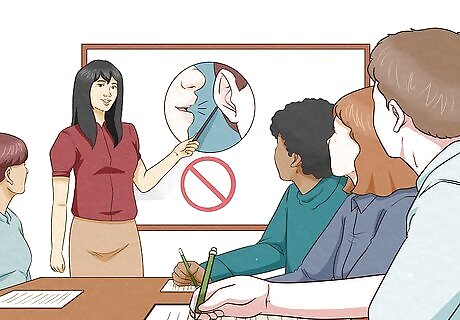
views
- Work to improve things such as your self-awareness, positivity, and confidence, as these are all important qualities of good leaders.
- Be firm and concise in your decisions, but be sure to include your team members and allow room for creative thinking.
- Gain your team members’ trust by treating them with compassion, providing them with opportunities to grow, and asking them for honest feedback.
Developing Leadership Qualities

Learn about yourself to develop your self-awareness. A good leader is in tune not only with their team members but with themselves as well. Reflect on your strengths, weaknesses, wants, and needs to figure out what kind of leader you are and what you need to improve to be even better. Think about how your personality traits will affect your team members. For example, if you know that you tend to be rather blunt when delivering feedback, make it a goal to learn how to give criticism in a more constructive manner. Or, if you know that you have really good organizational skills, use that to your advantage to make detailed itineraries and newsletters to keep your team members up to date.

Be confident, even when you don't have all the answers. Maintain good posture, make eye contact, keep your head up when talking, speak loud and clear, and use big hand gestures when you speak to emphasize key points. When you look and act confident, others will instinctively look towards you for guidance and reassurance. Not knowing something doesn't make you a bad leader. Ineffective leaders, on the other hand, get insecure and refuse to admit when they're wrong. There’s a fine line between confidence and arrogance. Acknowledge that you don't know everything, and avoid acting like you're superior to everyone. Instead of saying “I don't know” while looking down and fidgeting, say “I don't know the answer, but I'll look into it and get back to you” as you stand up straight and look the person in the eye.

Learn as much as you can about your field. Take every opportunity to refine your knowledge and become an expert on your industry, your field of study, or your career. Knowing what you're talking about will build your confidence and earn your team's trust. While it's impossible to know everything, your team might doubt your abilities if you say “I don't know” to every question they ask. For example, if you're the head of an engineering team, learn everything you can about the products you create, attend professional development events, and stay updated on relevant new technologies and software. Take time to study things that are outside of your relevant field as well to provide even more valuable information to your team. For example, a school principal might do research in the tech industry to provide teachers with up-to-date technology that they can use in the classroom.

Find a mentor who can teach you new skills. There's always room to grow, even if you're in a top leadership position. Reach out to a person you admire who has strong leadership skills. Ask them to chat over coffee or lunch, or see if they're open to being a long-term mentor. When you meet, ask them things like, “What qualities do you look for in a leader?” “How do you gain people’s respect?” and “What’s the most challenging part about being a leader?” and see what they have to say. Look for role models who've overcome challenges and reached goals similar to your own. For instance, if you're a young woman in high school or college, attend public speaking events by women in leadership positions.

Learn how to manage conflicts. A good leader is able to resolve conflicts between others at work without taking sides. If there's a heated disagreement between team members, work with them to identify the root of the issue and listen to both sides of the story. After that, open up a dialogue to begin looking for a solution that will benefit both parties. Suppose you run a factory, and a blueprint typo led to a canceled order. The salesperson is angry that they lost a commission and yells at the designer who made the typo. Instruct both of them to cool down, stress that getting angry is unacceptable, and assure them both that a new double-check system will be put in place to prevent future issues. If you’re in a professional setting, such as a corporate office, you might need to let HR handle an escalating conflict between employees.

Go into things with a positive mindset. Positivity is great for boosting your team’s morale, increasing productivity, and cultivating healthy relationships between team members. Even though things might not go smoothly 100% of the time, just making a conscious effort to think positively and bring that positive energy to your team and business can make others more excited to collaborate with you. Discouraging gossip and drama amongst team members can go a long way in creating a more positive environment. Be active in helping resolve conflicts and let others know you disapprove of gossip if they try to bring it up.
Leading a Team

Set clear rules and expectations and lead by example. To be a good leader, it’s important that you know what you want and communicate your expectations clearly to your followers. A good leader also doesn’t expect others to just blindly follow them, and they’ll usually make an effort to lead by example so that their followers will feel more reassured in their decision. For example: If you want to enforce a rule about cutting back on paper usage and recycling more, make sure others see you incorporating this rule into your daily routine. If you think that communication needs to be better among team members, take the initiative and contact each person for weekly or bi-weekly check-ins. If tardiness is a problem, make sure your team members see you arriving early to the office or meetings.

Be decisive and give clear directions. When you tell your team exactly what you want and how you want it done, you appear much more confident in yourself and your desired results. Take the time to gather all the necessary information needed to make a solid decision, then step up and confidently state exactly what you’re going to do. Suppose you and your friends are debating on what to do, but no one can agree on a plan. Step up and say, “Guys, we're going bowling.” This is an example of assessing the situation, rising to the top, and taking charge with confidence. However, if the group does not like this idea once you suggest it, model humility by stepping back and perhaps proposing a vote on two other ideas. Keep in mind that there will be times when you'll have to make decisions yourself and times when you'll need input from your team members. Be flexible and, if necessary, shift gears when new information becomes available. Don’t stick with your original decision if it’s going to cost you and your team a great amount.

Delegate tasks and provide the necessary resources. A leader doesn't micromanage their team or try to do everything themselves. When you assign tasks, define your expectations clearly and provide any necessary training or education. A good leader does what they can to set others up for success. Delegating responsibilities also shows that you trust other people to get the job done and be responsible. A clear expectation would be “Complete specification profiles for at least 5 installation projects by the end of the week.” A vague expectation would be “Do some specification profiles.” When you need to train someone, demonstrate the task yourself and narrate the steps as you perform them. If possible, observe them when they start and, if they make an error, gently correct them.

Perservere when things get difficult. A good leader doesn’t jump ship when things start to get hard. Even when things aren’t going exactly as planned, do your best to work through the issues and lead your team to success. Consult with other team members to get a fresh perspective, try a new method, or even take a short break from whatever project you’re working on so that you can come back reenergized later. Admitting that you’re having a hard time isn’t a sign of weakness. If anything, it will likely make you look more humble to your team members.

Encourage innovation and creative thinking. When it comes to problem-solving, it usually takes lots of collaborative thinking to come up with a solution. Instead of taking charge of everything, open up the floor for other people to come forward with their own ideas and suggestions. Give each one equal consideration and be open to changing your game plan if a good idea comes up. In addition to possibly solving a problem, this shows your team that you’re flexible and open-minded. Set time aside for a “brainstorming” session where everyone gets an equal opportunity to pitch their ideas.

Cultivate healthy relationships within your team. This includes your relationships with each of your team members and relationships among team members. Take the time to get to know your team as people rather than just colleagues or business partners. Swap stories, hang out outside of the office, and show a genuine interest in what’s going on in their lives. To encourage positive relationships between team members, do some team building exercises and encourage team members to help others when there’s a problem. For example, if a newer member of your team is having trouble getting the hang of things, pair them up with a senior team member so that they have a mentor they can learn from and talk to.
Earning Others’ Trust

Treat your team with respect and compassion. When someone comes to you with a problem, listen to what they have to say, give them your full attention, and do your best to empathize with their situation. Also, be sure to be respectful of their unique opinions and praise them for the things they’re doing well. Remember, you set the tone, so model the type of behavior you'd like your team to display. For example, if someone disagrees with you, listen to their argument and use their input to refine your decision. If you can't use their suggestion, let them know that you respect their opinion, but are going in another direction.

Keep your promises. When your team members see you fulfill the promises you made, it’s likely that their respect for you and trust in your abilities will grow. In order to keep promises, you have to know what's doable and what's not. Be realistic when you make a promise, and make sure it's something you can deliver. For example, don't promise your staff big raises unless you're 100% certain you have room in the budget. If you're an officer of a club at school, don't promise that you'll get more funding when you haven't even talked to your principal or school administration.

Provide your team with opportunities for growth. When you empower your team members by giving them ample room to grow and develop, they’ll likely be even more energized and excited to work with you. Provide professional development opportunities to help them with skills they may need in their career, give them constructive criticism about what they can improve on, and give them space to freely express their wants and needs. For example, invite guest speakers to come in to talk about things like time management, maintaining work-life balance, and goal-setting to inspire your team and equip them with important skills. Set up one-on-one meetings with each of your team members to discuss what they can improve on and what they’re doing well at work. In these meetings, come prepared with specific ideas of ways you can help them to continue improving their skills.

Ask for feedback from those you lead. Instead of waiting for someone to speak up, ask your team specific questions about how you can improve your performance. Schedule one-on-one meetings where each person can talk freely, or send out anonymous surveys to get everyone’s opinions. Remain flexible and open to all kinds of suggestions. Don't ask yes or no questions about whether or not they like you. Instead, ask specific questions, such as “In your opinion, what can I do to be a better leader” or “What are some ways I could communicate more clearly?”

Hold yourself accountable. Stand by your decisions, and take responsibility for the consequences. If things go wrong, step up and own up to your actions instead of throwing blame on someone else. In doing so, you’re also inspiring your team to be accountable when it comes to their own work and decisions. For example, if you’re the captain of a sports team and your team lost after using a play you designed, step up and take responsibility, but also stay positive for the future. Say something like, “I see what mistakes I made, and I now know what to do so that we can win next time.”

Give credit to others where it’s due. Humility is a very important quality of a good leader. When you celebrate successes, make sure you’re giving credit to everyone who was involved, not just yourself for leading the team. Take time to tell your team members that you appreciate them and the unique talents they bring. If you can’t talk to everyone in person, be sure to send out an email or group text to express your gratitude and give a shout-out to the people who led your team to success.

Dress in a way that's consistent with your role. Your appearance is another tool that can inspire confidence. Just be aware of the difference between dressing to impress and dressing to influence. Dressing to impress, or being overdressed, could drive a wedge between you and those you lead. For instance, if you manage a casual restaurant, wearing a suit and tie is impractical, might turn off your customers, and could alienate your staff. If you're the president of your high school class, wearing a crisp button-up or neat dress to a meeting is better than wearing ripped jeans and a stained, wrinkly t-shirt.



















Comments
0 comment